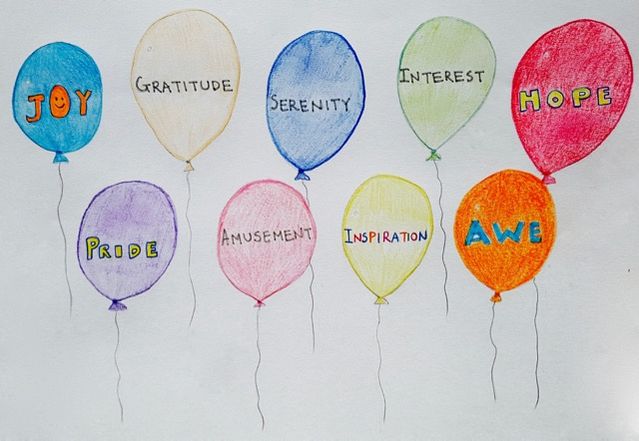Psychology
Positive Emotions and Well-Being
Insights from positive psychology.
Posted November 6, 2016 Reviewed by Abigail Fagan
In the decades following World War II, psychology as a science made notable strides in diagnosing and treating pathologies. While the contribution of psychological research on mental illness and adversity has enriched our understanding of the causes of human suffering, recent years have seen a resurgence of interest in the other side of the human experience – flourishing.
What factors contribute to human flourishing? What makes a good life? As a branch of psychology, positive psychology is the scientific study of positive human functioning, in other words, the exploration of the circumstances and conditions that enable individuals and communities to thrive. Among the three main concerns of positive psychology are positive emotions (sometimes referred to as the “tiny engines” of positive psychology), positive individual traits (e.g., compassion, optimism, resilience), and positive institutions (e.g., families, social relationships, communities). By examining the mechanisms behind these three pillars – the far-reaching ripples of positive emotions, the health effects of meaningful social connections, the protective properties of our strengths and virtues – we can take an important step towards understanding our well-being.

Dr. Barbara Fredrickson has been researching positive emotions for decades. Her work, along with the research of her colleagues, has shed light on how and why positive emotions are good for us. In particular, how despite their fleeting and subtle nature, the benefits of positive emotions echo long after their momentary pleasures have dimmed (“Happiness makes up in height for what it lacks in length,” Robert Frost once noted). As Fredrickson’s broaden-and-build theory posits, micro-moments of positivity accumulate over time and put people on a trajectory of growth by broadening their awareness and building their resources for survival.
The wealth of benefits of positive emotions is well documented. They improve physical health. They foster trust and compassion. They buffer against depressive symptoms and help people recover from stress. They can even undo the undesirable effects of negative emotions. With frequent experience and expression of positive emotions comes resilience and resourcefulness. Moreover, positive emotions foster better social connectedness.
How can we enrich our lives with more positive emotions (without regular lottery wins and frequent honeymoons)?
Opportunities, it appears, abound as far and as near the eye can see: taking a walk in nature, meditating, being open and warmhearted, living mindfully – to human kindness as much as to the taste of melting chocolate on the tongue. Then, there are our social connections, which according to Fredrickson’s research can become goldmines of positive emotions. In fact, merely reflecting on how attuned we feel with our daily interactions has been linked with an increase in the experience of positive emotions. One of the reasons behind the beneficial power of our connections lies in their ability to build positivity resonance (Fredrickson, 2013).
“When you share a smile or laugh with someone face to face, a discernible synchrony emerges between you, as your gestures and biochemistries, even your respective neural firings, come to mirror each other,” writes Fredrickson. “It’s micro-moments like these, in which a wave of good feeling rolls through two brains and bodies at once, that build your capacity to empathize as well as to improve your health.”

Positivity resonance, according to Fredrickson, can occur between anyone – from a close friend to a stranger behind you in the grocery line. Perhaps more encouraging, love – a key ingredient of positivity resonance, the most “generative” and “consequential” of all positive emotions, the driving force behind the health benefits of positive emotions – need not be confined to the embrace of a soulmate. It can, Fredrickson observes, bloom anytime people connect over shared positive emotions.
Research has shown that the difference between people who are flourishing and those who aren’t lies in the magnitude of positive emotions they are able to self-generate from everyday pleasant activities (e.g., social interactions, learning, helping others). Thus, according to positive psychology, what lies behind a good life, it seems, are not occasional grandiose gifts of fate. Rather, the ability to use our strengths and virtues for a purpose greater than ourselves, and a steady diet of micro-moments of positivity – however fleeting, however modest – that weave well-being from the hum of ordinary days. The best part is that occasions for such moments are much more prevalent than we might think.
Here is Dr. Fredrickson, in her own words.
What is the role of positive emotions for our well-being?
BF: “Our day-to-day positive emotions function as nutrients for our overall well-being. Today’s positive emotions do not simply exemplify today’s well-being, they also help to create next month’s increases in well-being.”
Why is gratitude important?
BF: “Gratitude is one of the easiest positive emotions to conjure up out of thin air. Simply ask yourself: ‘Which aspects of my current situation might I consider a gift to be cherished?’ and then allow yourself some time to cherish.”
How is love defined in positive psychology?
BF: “It’s important to consider love in its smallest forms, and not only for its role in romance and marriage. In my book Love 2.0, I define love as any moment in which positive emotions are shared between and among people, be it loved ones, friends, co-workers, or even strangers. These moments in which positivity resonates interpersonally appear to be especially potent nutrients for growth and well-being.”
What is loving-kindness meditation (LKM) and what benefits does it have?
BF: “For more than a decade, my collaborators and I have studied an ancient meditation practice called ‘loving-kindness meditation,’ which we at times abbreviate as ‘LKM.’ We find that LKM helps people to self-generate more positive emotions in daily life, and these emotions in turn build people’s resources and resilience, even their physical health, all of which improve their long-term well-being.” (Note: Dr. Frederickson’s Coursera course and her website PositivityResonance.com provide free guided meditations that you can try out if you wish.)
How is resilience acquired?
BF: “Our research reveals that one way that resilience is acquired is through daily experiences of positive emotions. Those among us who are more resilient experience more day-to-day positive emotions, and use these feelings to deal with the adversity and hassles we all face. In addition, this steady diet of positive emotions over time nourishes gains in resilience.”
What does it mean to prioritize happiness? (How can we increase positive emotions in our lives?)
BF: “Everyone is busy these days, so much so that we can become too focused on our “to do” list. Prioritizing positivity means also having a “to feel” list and scheduling time for activities that you know to be reliable elicitors of your own positive emotions. For me it’s spending time with a friend, walking in nature, or creating a new recipe.”
Why are positive social connections considered a health behavior and how can we increase their occurrence?
BF: “When we think of positive health behaviors, being physically active and eating our vegetables leap to mind. Positive social connections appear to be every bit as important to your long-term physical health. Here I mean old-fashioned, real-time connections – face-to-face and voice-to-voice. We can increase these not only by prioritizing enjoyable activities with our families and friends, but also by simply smiling and making eye contact with the clerk who helps you at the store, or the person sitting near you on your commute. These simple micro-moments of connection are surprisingly powerful.”
Many thanks to Dr. Barbara Fredrickson for being generous with her time and insights. Barbara Fredrickson is Kenan Distinguished Professor at the Department of Psychology and Neuroscience at University of North Carolina at Chapel Hill. She is the Director of the Positive Emotions and Psychophysiology Laboratory, and the President of the International Positive Psychology Association. She is the author of the books Positivity (2009) and Love 2.0 (2013) and more than 100 peer-reviewed articles and book chapters.
References
Catalino, L. I., & Fredrickson, B. L. (2011). A Tuesday in the life of a flourisher: The role of positive emotional reactivity in optimal mental health. Emotion, 11(4), 938–950.
Dunn, J. R., & Schweitzer, M. E. (2005). Feeling and believing: The influence of emotion on trust. Journal of Personality and Social Psychology, 88, 736–748.
Fredrickson, B. (2013). March 23. Your Phone vs. Your Heart. The New York Times. http://www.nytimes.com/2013/03/24/opinion/sunday/your-phone-vs-your-hea…
Fredrickson, B. L., Tugade, M. M., Waugh, C. E., & Larkin, G. R. (2003). What good are positive emotions in crises? A prospective study of resilience and emotions following the terrorist attacks on the United States on September 11th, 2001. Journal of Personality and Social Psychology, 84(2), 365–376.
Fredrickson, B. L. (2013). Love 2.0. New York: Hudson Street Press.
Fredrickson, B. L., & Levenson, R. W. (1998). Positive emotions speed recovery from the cardiovascular sequelae of negative emotions. Cognition and Emotion, 12(2), 191–220.
Fredrickson, B. L. (2013). Positive emotions broaden and build. Advances in Experimental Social Psychology, 47(1), 53.
Fredrickson, B. L. (2001). The role of positive emotions in positive psychology. The broaden-and-build theory of positive emotions. American Psychologist, 56(3), 218–226.
Howell, R. T., Kern, M. L., & Lyubomirsky, S. (2007). Health benefits: Meta-analytically determining the impact of well-being on objective health outcomes. Health Psychology Review, 1, 83–136.
Kok, B. E., & Fredrickson, B. L. (2010). Upward spirals of the heart: Autonomic flexibility, as indexed by vagal tone, reciprocally and prospectively predicts positive emotions and social connectedness. Biological Psychology, 85(3), 432-436.
Lyubomirsky, S., King, L., & Diener, E. (2005). The benefits of frequent positive affect: Does happiness lead to success? Psychological Bulletin, 131(6), 803–855.
Mauss, I. B., Shallcross, A. J., Troy, A. S., John, O. P., Ferrer, E., Wilhelm, F. H., et al. (2011). Don’t hide your happiness! Positive emotion dissociation, social connectedness, and psychological functioning. Journal of Personality and Social Psychology, 100(4), 738–748.
Nelson, D. W. (2009). Feeling good and open-minded: The impact of positive affect on cross cultural empathic responding. Journal of Positive Psychology, 4, 53–63.
Ong, A. D., Bergeman, C. S., Bisconti, T. L., & Wallace, K. A. (2006). Psychological resilience, positive emotions, and successful adaptation to stress in later life. Journal of Personality and Social Psychology, 91(4), 730–749.
Seligman, M. E., & Csikszentmihalyi, M. (2000). Positive psychology: An introduction. American Psychologist, 55 (1), 5-14.
Seligman, M. E. P. (2002). Positive psychology, positive prevention, and positive therapy. In C. R. Snyder & S. J. Lopez (Eds.), Handbook of positive psychology (pp. 3–9). New York: Oxford University Press.
Seligman, M. (2002). Authentic happiness: Using the new positive psychology to realize your potential for lasting fulfillment. New York: Free Press.
Winter, A. (2014). The One You’re With Barbara Fredrickson On Why We Should Rethink Love. The Sun. http://thesunmagazine.org/issues/463/the_one_youre_with




